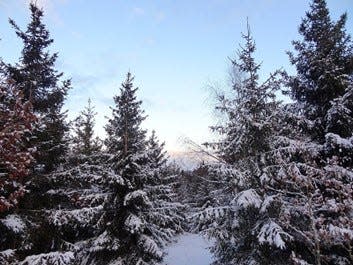Ken Baker: Trees don't freeze in winter

No orchard’s the worse for the wintriest storm; But one thing about it, it musn’t get warm. How often already you’ve had to be told, “Keep cold young orchard. Good-bye and keep cold. Dread fifty above more than fifty below.” -Robert Frost, Good-bye and Keep Cold
Many fruit and nut trees require a significant period of cold weather in order to produce a good crop of fruit the following fall. Apples, pears, plums, peaches, and cherries are among those orchard trees that need a certain number of “chill hours”— the amount of time in which winter temperatures hover between 32 and 45 degrees F — for an ample harvest.
Interestingly, as Frost notes in his poem, it doesn’t much matter for many of our northern trees how far below freezing the thermometer drops, so long as they have adequate time to adjust to the coming on of a deep freeze.
Why doesn’t prolonged subzero weather kill our maples, beeches, and apple trees, like it would most tropical trees?
Botanists talk about a plant’s cold hardiness, which is its ability to acclimate — that is, alter its anatomy and physiology — to improve its ability to deal with the onset of winter’s cold. “Tender” plants have little cold hardiness and are killed by freezing temperatures, while “hardy” plants can survive freezing to different levels.

Trees have evolved to cope with cold temperatures
Our cold hardy trees have evolved various workarounds to deal with a wide array of problems brought on by freezing temperatures. Let’s consider three: drought, bubbles, and crystals.
Drought: In order to turn sunlight into energy-rich sugars, the photosynthetic machinery within a tree’s leaves requires both water and carbon dioxide. But when soil temperatures drop below 32 degrees, liquid water turns to ice and the roots can’t absorb the necessary moisture to send up the trunk to the leaves.
Meanwhile, at the top of the tree, the problem is compounded by the fact that the cold air surrounding the leaves is dry. And that’s an issue because the under-surface of every leaf has hundreds of tiny holes (stomata) through which the leaf gets its carbon dioxide. But the dry air of winter can quickly drain water from inside the leaf through those openings.
Workarounds: While deciduous trees shed their leaves in late fall, eliminating most of the trees’ need for water, conifers keep the majority of their leaves (or needles) throughout the cold season, protecting them from losing too much water with a thick waxy outer coating.
But a conifer’s beautiful green color indicates its photosynthetic machinery is still intact and ready to absorb energy from sunlight falling on the leaves. Not good; it’s too cold for photosynthesis and starting up the process can cause a lot of weird chemical damage. The needle protects itself with a compound called violaxanthin that absorbs light before it triggers photosynthesis, converting it into heat that can be harmlessly dissipated.
Bubbles: The vascular system of a plant consists of two types of straw-like tubes, phloem and xylem. Phloem is the name for the tubes that carry sugars (made by photosynthesizing leaves) down the trunk, and xylem consists of tubes that carry water and dissolved minerals from the roots up to the leaves. (Most of a tree’s trunk is made of xylem.)
As winter advances and the water within these tubes cools, gases that had been dissolved in the water coalesce to form bubbles. The problem is that when things warm up in the spring, the bubbles remain, blocking the movement of water and nutrients up the trunk.
Workaround: This one’s odd. For physical reasons I don’t understand, such bubbles are less likely to form in tubes that have a narrow width. Cold hardy trees of the northern hemisphere tend to have skinnier vascular tubes than those in the tropics.
Trees concentrate sugars within their cells in fall
Crystals: In turning from liquid to ice, water forms sharp, many-pointed crystals that could easily puncture the delicate membranes that surround the cells of a plant.
Workarounds: Both deciduous and coniferous trees concentrate sugars within their cells as autumn advances. This does three things: The contents of the cells become viscous (it’s called the “glass phase”), slowing chemical activity way down within the cells. Second, the sugars act as an antifreeze making it harder for any remaining water in the cells to freeze.
Third, a lot of the water that had been inside the cells moves into spaces between the cells and into the phloem and xylem tubes, leaving any dissolved minerals or nutrients in the cells. This results in very pure water within the vascular tissues. Since ice needs a mineral or some other “seed” to begin forming, this can lower the temperature at which water in these tissues freezes from 32 down to as much as -55 degrees.
But a late winter warm spell followed by a period of renewed freezing weather can throw a serious monkey wrench into the works, as plants begin to de-acclimate to the cold too soon.
Dread fifty above, says the poet, more than fifty below.
Ken Baker is a retired professor of biology and environmental studies. If you have a natural history topic you would like Dr. Baker to consider for an upcoming column, please email your idea to fre-newsdesk@gannett.com.
This article originally appeared on Fremont News-Messenger: Baker: Trees don't freeze in winter, they developed workarounds
